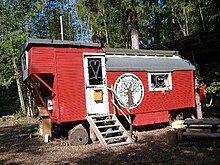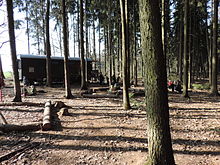Forest kindergarten
The forest kindergarten or nature kindergarten is a form of kindergarten that comes from Scandinavia . In the forest kindergarten, children between the ages of three and six years (sometimes under three years of age) experience upbringing, education and care. Most activities take place outside permanent buildings, mostly in the forest.
Historical
Ella Flatau from Sölleröd in Denmark founded the first forest kindergarten in the 1950s, after she had often gone to the forest with her own children and those of the neighborhood, and this form of childcare aroused great interest among other parents. Interested parents got together and founded an initiative that brought the first forest kindergarten to life - an idea that spread throughout the Scandinavian region. The first German-speaking forest kindergartens also emerged in Denmark in the early 1990s. The first forest and nature kindergarten in Germany was established in 1968 in Wiesbaden. The founder, Ursula Sube, organized this forest kindergarten privately - with the support of Pastor Bernbeck from the Thomas parish - but never received official approval for this form of kindergarten from the responsible youth welfare office.
The forest kindergarten movement did not gain wider acceptance in Germany until the 1990s. The first recognized forest kindergarten started on May 3, 1993 in Flensburg. Numerous new groups are currently being formed. Today there are well over 1500 (as of October 2017) forest kindergartens in Germany, 23 forest kindergartens in Austria, various forest kindergartens and crèches in Switzerland and South Tyrol. In addition to the forest kindergartens, there are also forest and animal kindergartens, where the children also take care of the care and care of animals.
Starting in 2018, all forest and nature kindergartens are invited to celebrate International Forest Kindergarten Day as a special day of action on May 3rd of each year.
conditions
The forest kindergarten is often referred to as a “kindergarten without a roof or walls”. The main difference to conventional kindergartens is that the supervised children and their educators are almost always outside of buildings. H. in the forest, on the meadow or on the beach. The outdoor activities take place in all weather conditions; There are only restrictions in the event of weather conditions that make it impossible to stay outdoors safely. In Germany, heatable accommodation is prescribed in reasonable proximity to the forest area, in which children and educators can find shelter and residence in very bad weather conditions. A heated construction trailer or a forest hut are usually used for this purpose . In the forest kindergarten, common toys are usually not used. The children play with natural objects that they find in their surroundings. The prescribed group size for a forest kindergarten is 15 to 20 children with a key from at least two state-approved educators. Apart from these framework conditions, the forest kindergartens present themselves as normal kindergartens in which children are educated, accompanied and brought up. In the meantime, there are proven training and further education offers for a job as a pedagogical specialist in the forest kindergarten.
The legal form of a forest kindergarten is usually the registered association (eV). The educational staff are then employees of this association. A forest kindergarten is financially supported by state grants, donations and parental contributions. However, government grants vary from place to place. Occasionally, the educators run the forest kindergarten on their own and conclude private-law contracts with the parents .
Effects of forest kindergarten pedagogy
There are now a number of scientific papers on the effects, advantages and opportunities of forest kindergarten pedagogy (e.g. Grahn et al 1997; Gorges 1999, 2002; Häfner 2002; Huppertz 2004).
The daily stay in the great outdoors supports a positive development of the child's motor skills and perception in the areas of gross and fine motor skills, coordination , tactile perception and deep sensitivity . Children who have attended a forest kindergarten are no less well prepared for school requirements than children who have attended a regular kindergarten - they are even given slightly better grades in the majority of areas (Häfner 2002; Gorges, 1999, 2002). Children in the forest kindergarten are healthier stable, have fewer accidents and fall more safely. Since most forest kindergartens conceptually do not use conventional toys with a "prescribed" meaning and the children play with natural objects, forest pedagogy also has a supportive effect on language development, because the children more often verbally exchange information about the meaning of objects and what happens in the game (Warmbold 2002) . In the forest kindergarten, children and educators are generally less exposed to noise than in closed rooms. Traditional kindergartens have a higher level of noise pollution and therefore an increased level of stress for children and educators. Positive effects on the immune system of children and educators from spending hours outdoors were also found (Warmbold 2002).
Another effect of forest kindergarten pedagogy is on another level: Since the increased establishment of forest kindergartens in Germany and discussions and publications on this topic, more and more kindergartens have included forest days, forest weeks or forest projects in their program. In this way, they try to give their children the benefits of forest kindergarten education, at least temporarily.
With the spread of ticks in Germany, Austria and Switzerland, forest kindergartens have lost their popularity, as people are regularly affected by diseases such as Lyme disease , early summer meningoencephalitis , babesiosis , ehrlichiosis or rickettsiosis . Life-threatening tick bites are also a risk in the forest kindergarten during the warmer seasons. However, there is now an effective vaccination against early summer meningoencephalitis. Since then, sports kindergartens have increasingly tried to achieve the advantages of forest kindergartens without the health risks (Arnd Krüger 1990).
literature
- Paxis Kita , March 2018, issue 51. Main topic: Kindergarten in the forest .
- Katharina Free Life, Regina Michael-Hagedorn: Children under the canopy of leaves: planning and creating forest experiences. 2nd Edition. Modern learning, 2003, ISBN 3-86145-184-0 .
- Roland Gorges: Does the forest kindergarten neglect the ability to attend school? In: KiTa aktuell. (Edition Baden-Württemberg) 5/1999, ISSN 0943-0237 , pp. 113-117.
- Roland Gorges: Forest kindergarten children in the first year of school. An empirical study. In: Zeitschrift für Erlebnispädagogik. 7/8, Lüneburg 2002, ISSN 0933-565X , pp. 10-18.
- Peter Häfner: Natural and forest kindergartens in Germany - an alternative to regular kindergartens in pre-school education . 2003, DNB 967124190 (Dissertation University of Heidelberg October 18, 2002, 203 sheets with graphic representations, 30 cm, full text online PDF, free of charge, 202 pages, 454 KB).
- Norbert Huppertz : Manual forest kindergarten. Conception. Methodology. Experiences (= element . Volume 7). PAIS, Oberried near Freiburg im Breisgau 1999, ISBN 3-931992-18-7 .
- Michael Kalff: Handbook on nature and environmental education. Theoretical foundation and practical instructions for a deeper understanding of the world . Ulmer, Tuningen 2001, ISBN 3-924191-71-9 .
- Sabine Köllner, Cornelia Leinert: Forest kindergartens, a guide for activities with children in the forest . (= Publication series of the BDF Fachverband Forst. Volume 6). RIWA, Augsburg 1997, ISBN 3-932374-05-3 .
- Arnd Krüger : When should children start exercising? In: P. Lösche (Ed.): Göttinger Sozialwissenschaften today. Vandenhoeck & Ruprecht, Göttingen 1990, ISBN 3-525-35838-5 , pp. 278-308.
- Ingrid Miklitz: The forest kindergarten. Dimensions of an educational approach. 4th edition. Cornelsen, Berlin 2011, ISBN 978-3-589-24739-4 .
- Rudi Vorteilel: Experience the forest with children. Southwest, 1999, ISBN 3-517-07650-3 .
- Kathrin Sandhof, Birgitta Stumpf: With children in the forest. Forest experience manual . Ökotopia, Münster 1988, ISBN 3-931902-25-0 .
- Sandra Schaffert. The forest kindergarten. In: Martin R. Textor (Ed.): Kindergarten pedagogy. 2004. (online manual)
- Hans-Georg Schede: The forest kindergarten at a glance . Herder, Freiburg im Breisgau / Basel 2000, ISBN 3-451-27403-5 .
- Alexandra Schwarzer: Schaukelfee and Klettermax - rope play equipment in the forest for children . ProBusiness, 20006, ISBN 3-939000-75-2 .
- Wiebke Warmbold: Cultural education in the forest kindergarten. An investigation into elementary cultural education and aesthetic practice . Thesis . Grin, Munich 2002.
Web links
- Federal Association of Natural and Forest Kindergartens in Germany
- Federal working group of the regional associations of forest and nature kindergartens in Germany
- Schutzgemeinschaft Deutscher Wald - Waldkindergarten - Background information on the topic of forest kindergartens
- Dissertation on the forest kindergarten , Heidelberg University , PDF (454 kB)
- Overview of the forest kindergarten development in Switzerland
- Forest kindergarten in the area of Landesforsten Rhineland-Palatinate
- Regional Association of Forest and Nature Kindergartens in Bavaria ; not conclusive
- Forest and nature kindergartens Landesverband BW
- Regional association of forest and nature kindergartens in North Rhine-Westphalia
- Regional association of forest and nature kindergartens RLP
- [1] - On the history of the forest kindergarten
Individual evidence
- ↑ Jan Peters: 25 years of the forest kindergarten - this is celebrated , Der Nordschleswiger from September 15, 2018.
- ↑ Manfred Berger: On the history of the nature and forest kindergarten
- ^ Federal Association of Natural and Forest Kindergartens in Germany V. | about us
- ^ Forest kindergartens in Austria
- ^ Forest kindergartens in Switzerland
- ↑ Home | Forest children Basel. Retrieved September 16, 2017 .
- ↑ South Tyrol: We children from the forest. Retrieved June 29, 2018 .
- ↑ Seehaus forest and animal kindergarten
- ↑ Ditzingen nature and animal kindergarten
- ^ Freiburg nature school - advanced and advanced training
- ^ P. Grahn, F. Mårtensson, B. Lindblad, P. Nilsson, A. Ekman: Ute på dagis. Hur använder barn daghemsgården? Utformningen av daghems-gården and the operation for lek, motor skills and concentration form. In: Stad & Land. no 145, 1997, Alnarp / Sweden.


